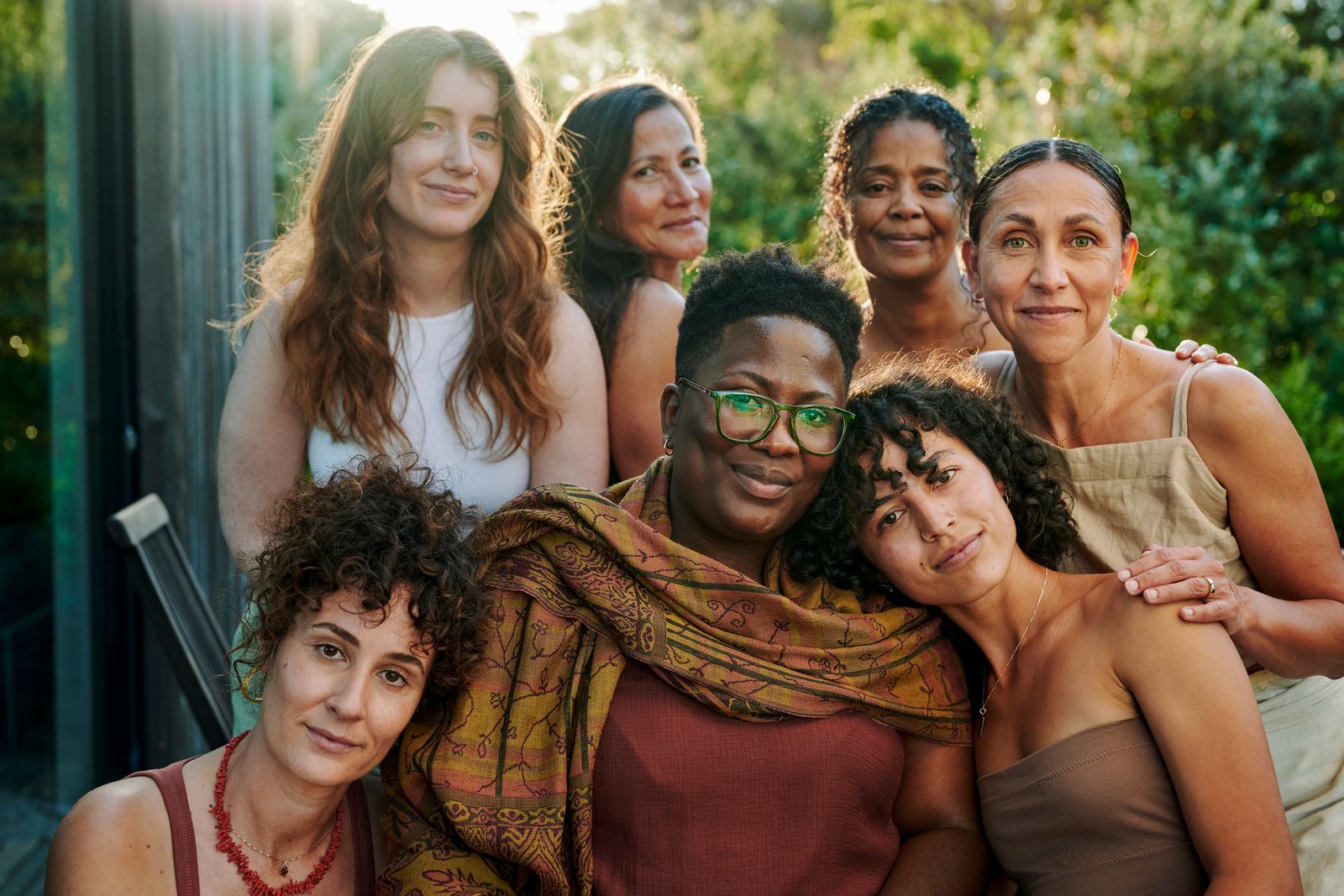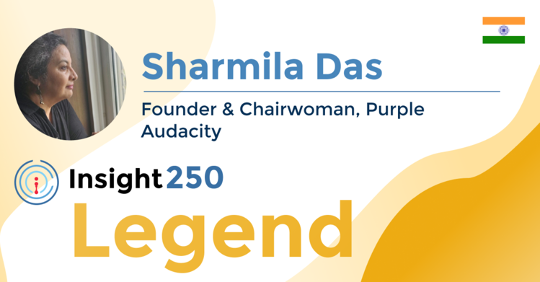The Growing Impact of Women
This edition features Sharmila Das, Chairwoman of Purple Audacity, discussing her observations, based on 40 years of experience as an Insights and Strategy professional, on the evolving roles and challenges of women in India and across the globe.

With so many exceptional professionals named to the Insight250, it seems fitting to tap into their expertise and unique perspectives across various topics. This regular series does just that: inquiring about the expert perspectives of many of these individuals in a series of short topical features.
This edition features Sharmila Das, Chairwoman of Purple Audacity, discussing her observations based upon 40 years of her experience being an Insights and Strategy professional, on the evolving roles and challenges of women in India and across the globe. I hope everyone finds this as insightful as I did - enjoy. Thank you Sharmila.
Crispin: Sharmila, you’ve been at the forefront of studying subjects involving women. I understand that these have ranged from shopping to contraceptive choices to financial choices; across different products and services, across urban and rural areas of India. What significant changes have you observed in women's roles over the past few decades?
Sharmila: “The transformation has been nothing short of revolutionary. We’re witnessing a paradigm shift in women’s aspirations, their participation across various spheres, and most crucially, in their sense of agency. The Millennials and GenZ are at the forefront of the changes we are witnessing and it is heartening to see the transformation happening in smaller towns and some parts of rural India, too.
“Education has been a game-changer. A 23-year-old semi-urban student told me, “My dream is to get a good job. Earn more. Lead a good life.” This ambition reflects a seismic shift in attitudes towards women's education and career aspirations.
“In the economic sphere, we’re seeing a surge in women’s entrepreneurship. A small business owner shared "I used to be alone in the house. What will I do sitting idle? I told my husband about it. I won’t go out and work. He does not like me to do work outside. He said that you do whatever you like but do it from home. That is why I started this business.” This growing economic independence is reshaping power dynamics within families and communities. While these changes are significant, they’re not uniform across all segments of society. The journey towards gender equality is ongoing, with persistent challenges that we must continue to address.”
Crispin: You’ve mentioned that Indian women are changing faster than the society around them. Can you elaborate on this?
Sharmila: “When I say Indian women are changing faster, I’m referring to the rapid evolution in three areas:
1. their aspirations
2. capabilities
3. actions
“These three are often outpacing the societal structures that have traditionally defined their roles. A sweet example might be of this young 20 year old who came to a village from a small town post her marriage. Her desire to celebrate Valentine’s day with her husband that she had seen in her town is an example of her aspirations and actions. A starker example is the recent response of women across different towns and cities to the violence and power dynamics against the young doctor who was found raped and dead at a Kolkata hospital.
“Today’s protests are markedly different - more organized, more assertive, and crucially, more solution-oriented. Women are not just expressing outrage; they’re demanding systemic changes and actively participating in policy discussions. We’re seeing women take charge of their lives in unprecedented ways. A 29-year-old urban professional told me, “I would get married only when I am prepared for that.” This level of assertiveness in personal decision-making was rare just a generation ago.
“While this rapid change is encouraging, it often creates tension. As women push boundaries, they frequently encounter resistance from traditional power structures struggling to adapt. This dynamic tension between progress and pushback defines the current landscape for women in India.”
Crispin: In which areas have you noticed the most significant changes?
Sharmila: “The changes are multifaceted and far-reaching. Let me highlight five key areas:
“1. Technology Adoption: The digital revolution has been a great equalizer. A 19-year-old from a small town shared, “I use my phone for everything -- taking pictures, listening to music, WhatsApp... I even learned how to speak English using YouTube.” This digital savviness is opening up new avenues for learning and economic opportunities.
“2. Financial Decision-Making: We’re seeing a shift towards more collaborative financial decisions in families. A rural homemaker told me, “We both decide and buy. Almost always we both decide.” This represents a significant departure from traditional patriarchal norms.
“3. Health Awareness: Women are becoming more assertive about their health and reproductive rights. That said, challenges persist, particularly in rural areas where economic pressures and gender biases still influence health decisions.
“4. Workforce Participation: While still low compared to global/ideal standards, we’re seeing more women enter the formal workforce and pursue diverse careers. This is gradually changing perceptions about women's roles in society.
“5. Political Engagement: Women are increasingly vocal about political issues and are demanding greater representation in political processes.
“These changes are significant, yet it's crucial to recognize that they're not uniform across all segments of society. The urban-rural divide, in particular, remains a critical factor in the pace and extent of these changes.
Crispin: How are changing societal norms contributing to the evolving roles of women in India?
Sharmila: “We’re witnessing a gradual tendency towards challenging the traditional patriarchal norms, especially in urban and semi-urban areas. The perception of women’s education, for instance, has undergone a dramatic shift. It’s no longer seen merely as a path to a good marriage, but as essential for personal and professional growth.
“Family dynamics are evolving, with women having more say in household decisions. Media and popular culture are playing a crucial role, with more representation of strong, independent women in films, television, and advertising. Bollywood movies have started providing a different narrative about the agency that women have through some very popular movies recently i.e. the feisty Rani from Rocky aur Rani ki Prem Kahani, or the determined Jaya and Phool from Lapata Ladies.
“At the same time, it’s important to recognize the complexity of this picture. In many parts of India, especially rural areas, traditional norms still hold sway. The preference for male children remains a significant issue in some communities. Moreover, the increasing visibility and assertiveness of women in public spaces has sometimes led to backlash.
“Despite these challenges, the overall trajectory is towards more equitable norms, driven largely by women themselves who are refusing to accept the status quo. It's a process of continuous negotiation and renegotiation of social norms.”
Crispin: How is financial independence reshaping the economic landscape for women in India?
Sharmila: “Financial independence is proving to be a powerful catalyst for change. It’s giving women more say in financial decisions, both at home and in their communities. The ripple effects of economic empowerment are significant. It’s leading to delayed marriages, more investment in girls’ education, and a gradual shift in societal perceptions about women’s roles. As women become breadwinners, their status within families and communities is improving.
“Despite these positive trends, challenges persist. The gender pay gap remains a concern, and women often face discrimination and harassment in the workplace. Balancing work and family responsibilities continues to be a significant challenge for many working women.”
Crispin: How is digital literacy and access to technology impacting women’s lives, especially in rural areas?
Sharmila: “Technology is playing a transformative role in women’s lives across India, including in rural areas. It's a complex picture with both opportunities and challenges. Digital technology is opening up new avenues for entertainment, education, employment, and empowerment. Mobile phones are helping women redefine their identity and relationships. I remember the joy with which a young married woman with a toddler narrated how she watches movies with her husband on the mobile phone that the husband owns. It is interesting that the mobile phone is offering opportunities of inter-spousal interactions in rural areas too which earlier had very little scope of regular interaction for the young couple due to men and women occupying different spaces of the household during day time.
“Women now mention having access to information about better housekeeping, stitching their own clothes, food recipes, health, agriculture, and government schemes. They’re also enabling women to participate in the digital economy through online selling and digital payments.
“While these developments are encouraging, we must be cautious about overstating the impact, especially in rural areas. The digital divide is real and often follows existing socio-economic divides. Many women, particularly in rural areas, still lack access to their personal smartphones or the internet.
“Additionally, there’s often a gender gap in technology use within households. In many families, men control access to digital devices, limiting women’s ability to benefit from them. Privacy and online safety are other significant concerns, especially for younger women. The fear of online harassment or misuse of personal information can deter women from fully engaging with digital platforms.
“Despite these challenges, I remain optimistic about the potential of technology to empower women, especially in rural areas. Realizing this potential will require concerted efforts to improve access, enhance digital literacy, and create safe online spaces for women.”
Crispin: What are the future implications of these changes for individual women and society at large?
Sharmila: “The implications are far-reaching and multifaceted. At an individual level, we’re seeing a marked shift in how women perceive themselves and their place in society.
“Increased education and economic opportunities are giving women a stronger sense of self-worth and independence.
“At a societal level, as more women enter the workforce and gain financial independence, we’re likely to see a shift in family structures and dynamics. This could lead to delayed marriages, lower fertility rates, and more investment in children’s education, especially girls’ education.
“Economically, increased women’s participation in the workforce could significantly boost India’s GDP. This economic empowerment is likely to translate into greater political participation and representation for women.
“The other side of the story is that we may see increased social tension as traditional power structures are challenged. The backlash against women’s empowerment, sometimes manifesting as violence, is a concerning trend that requires our attention.
“The technological revolution is likely to accelerate many of these changes. As digital literacy improves, we could see more women leveraging technology for education, entrepreneurship, and social networking. This could be particularly transformative in rural areas.
“In essence, while the overall trajectory is positive, the path forward is likely to be non-linear,
with progress and setbacks along the way. How we as a society navigate these changes will be crucial in determining the future of gender equality in India.”
Crispin: How are businesses adapting to meet the demands of this empowered demographic?
Sharmila: “Businesses are recognizing the fast growing and significant influence of women in decision making however in my opinion they are yet to keep pace with the rapid change that is happening. The tokenism of advertisements on International Women’s day and contributing to women through CSR activities is slowly getting replaced with a recognition of their financial and decision making roles and we are seeing signs of women focused initiative i.e. an entire range of female hygiene products that were hitherto unknown in the Indian market, or communication showing different facets of a woman instead of being confined to the ’I-am-the-caregiver’, or ‘I-am-delicate’ narratives.
“We’re seeing changes across various sectors. In the financial sector, there’s a growing focus on products tailored for women, including specialized savings accounts and investment options. The rise of digital financial services is particularly significant, as it’s making financial products more accessible to women, even in rural areas through the formation of self-help groups.
“In the consumer goods sector, companies are redesigning products and marketing strategies to appeal to women consumers. This goes beyond just changing packaging colours; it involves understanding and addressing women’s specific needs and preferences. The healthcare industry is another area seeing significant changes. There’s a growing focus on women’s health issues, with more products and services tailored to women’s specific health needs.
“In the technology sector, we’re seeing efforts to make products more user-friendly for women, especially those who may be first-time technology users. Businesses are recognizing the potential of technology to reach and empower women consumers. While these adaptations are promising, there’s still considerable room for improvement.
“Many women, particularly in rural areas, remain underserved by the market. There’s a need for more inclusive product design and marketing strategies that cater to diverse groups of women consumers.”
Crispin: As we conclude, what call to action would you give to our audience to contribute positively to the empowerment of women?
Sharmila: “My call to action is this: Recognize that empowering women is not just a women’s issue – it’s a societal issue that benefits everyone. Each of us has a role to play in this transformation, and very focused initiatives, starting at homes and primary schools, will have to be taken to also change the men. During a project in a rural area, I had witnessed how a 360-degree initiative by an NGO which had included empowerment sessions at school for the young girls as well as outreach for their parents and communities, had resulted in some of those girls being able to go for higher studies instead of getting married even before attaining the legal age of marriage.
1. Prioritize education for girls and women at all levels. Education is not just about literacy; it’s about opening minds and possibilities.
2. Challenge gender stereotypes in your daily life. Encourage girls and women to pursue their ambitions, whether in education, career, or personal life.
3. Support women entrepreneurs. If you’re in a position to do so, invest in or support women-led businesses.
4. Promote digital literacy. Help women access and effectively use digital technologies for personal and professional growth.
5. Advocate for policy changes that promote gender equality, whether in your workplace, community or at a national level.”
Crispin: Sharmila, thank you for this in-depth conversation on such an important topic to our societies and for sharing your expertise in this realm. It is incredible to see such progress and impact by so many women around the world and across the insights industry.

Crispin Beale
Chairman at QuMind, CEO at Insight250, Senior Strategic Advisor at mTab, CEO at IDXCrispin Beale is a marketing, data and customer experience expert. Crispin spent over a decade on the Executive Management Board of Chime Communications as Group CEO of leading brands such as Opinion Leader, Brand Democracy, Facts International and Watermelon. Prior to this Crispin held senior marketing and insight roles at BT, Royal Mail Group and Dixons. Crispin originally qualified as a chartered accountant and moved into management consultancy with Coopers & Lybrand (PwC). Crispin has been a Board Director (and Chairman) of the MRS for nearly 20 years and UK ESOMAR Representative for c15 years. As well as being CEO of Insight250, Crispin is currently Worldwide CEO of Digital Communications Solution Agency, IDX. Crispin is also the Senior Strategic Advisor at mTab and the Chairman of QuMind and spent 4 years as Group President of Behaviorally where he was responsibile for the client & commercial teams globally. Crispin is a passionate advocate for blending human intelligence and technology to deliver innovation and leadership across organisations.


